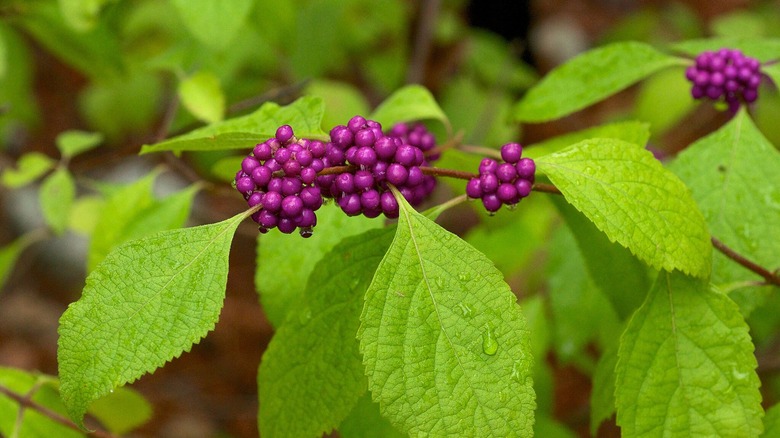Bring All The Cardinals To Your Yard With This Gorgeous Berry Bush
If you live anywhere in the United States that is east of the Rocky Mountains you've probably seen a Northern cardinal. These distinctive birds have brilliant red feathers, a black mask, and a tall pointed crest. They're so well-liked, in fact, that they are the official state bird of seven states: Illinois, Indiana, Kentucky, North Carolina, Ohio, Virginia, and West Virginia. It's no surprise that people would like to attract such popular and beautiful birds to their own backyards — and the key to doing it may be in their favorite treat.
Almost anyone with a bird feeder knows that cardinals like sunflower seeds, but they actually have an extremely varied diet, eating beetles, caterpillars, snails, seeds of all kinds, flowers, fruits, and berries. Berries are a particular favorite, and when they start appearing on bushes they're often accompanied by flocks of hungry cardinals. One berry bush, in particular, is an excellent choice for gardeners hoping to bring these beloved birds to their yards: the American beautyberry.
American beautyberry
American beautyberry, also called French mulberry, is an excellent choice for birders who would like to see more cardinals, robins, and finches of all kinds flocking in their backyards. These plants are from the Southeastern United States, the Caribbean, and Northern Mexico. As noted by the USDA, they grow best in pine forests where the earth is loamy and damp, but it is possible to grow them elsewhere if the conditions are right.
When there aren't berries on the shrubs they are fairly average looking, growing about 3-5 feet tall. The berries are, as the name suggests, exceptionally beautiful. They are small, brilliantly purple, and grow in clusters all over the plant. These berries are a favorite nutritious food of more than 40 different types of songbirds, including cardinals, and are also enjoyed by mammals like foxes, opossums, raccoons, and deer. The berries usually come out in late summer and autumn, when they can be an important late season food for wildlife.
Bringing home a beautyberry
You can attract cardinals and other berry-hungry birds like warblers, mockingbirds, thrushes, and catbirds to your yard with an American beautyberry. These plants do best in part sun to shade, mimicking where they grow in the wild, and prefer soil that's slightly on the moister side of average.
If you live in the Southeastern United States, these bountiful shrubs are available in most nurseries and big box stores. For those further north, it may be slightly harder to find one, but they are available to order from nurseries online. When looking for the perfect shrub to bring cardinals to your yard, however, be careful that what you're buying is actually American beautyberry — Japanese beautyberry is also a beautiful plant, but is not as appealing to birds.
For maximum enjoyment, plant this shrub in a location that you can see from your window, so that you can discreetly watch the cardinals sheltering in its branches and gorging itself on the delicious purple berries.
Other berries for cardinals
Cardinals love the American beautyberry, but there are other options for ambitious backyard birders to plant.
Serviceberry is another beautiful option. They are small trees which bloom with pretty white flowers in spring and then grow small purple-ish red small fruits. Cardinals are particularly attracted to these fruits, but finches, robins, and bluejays will likely also visit to enjoy them! Elderberries, like serviceberries, are extremely attractive to many species of birds, many of which rely on fruits and berries to survive their migration. Elderberry doesn't produce berries that are as brilliantly colored as beautyberry, but they do have attractive red stems. Cardinals and other birds can be seen flocking to the heavy clusters of black berries in the autumn.
Of course, the best shrub for feeding your local cardinals is the one that grows easily in your garden, so it's important to always check which plants are native to your area and enjoy the light and soil conditions that happen to be in your backyard.



